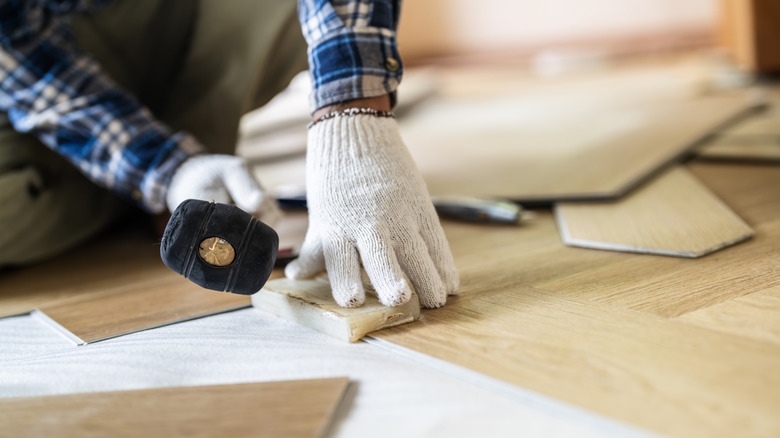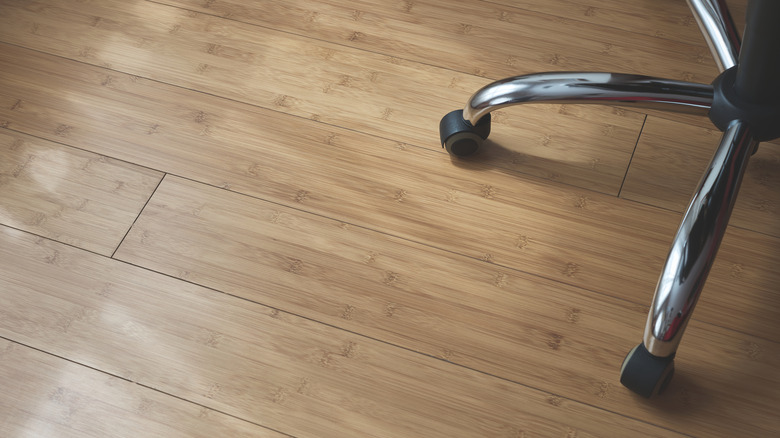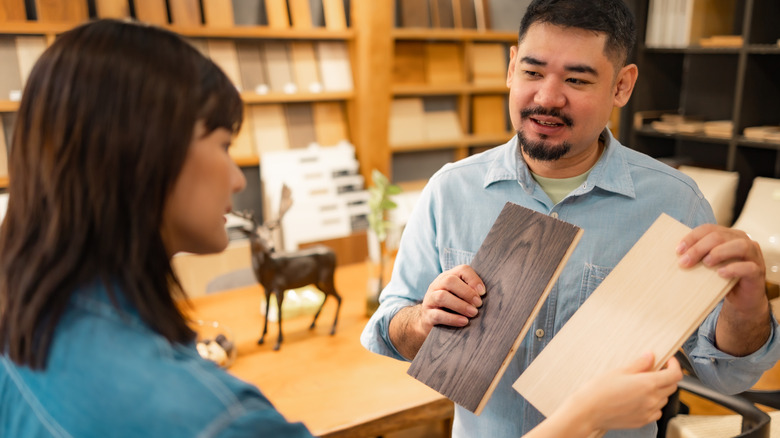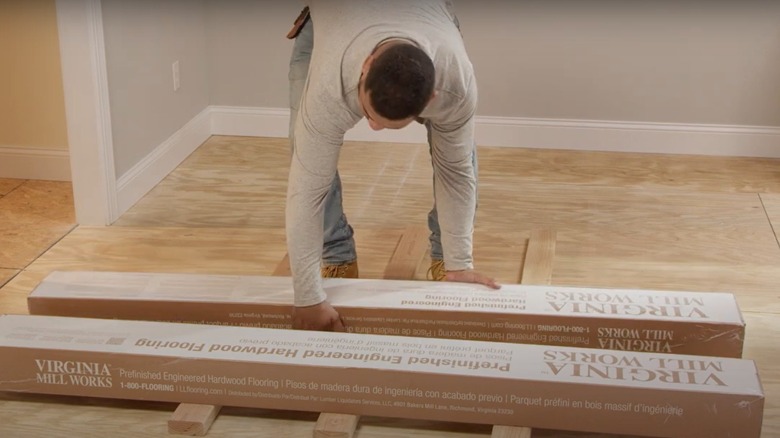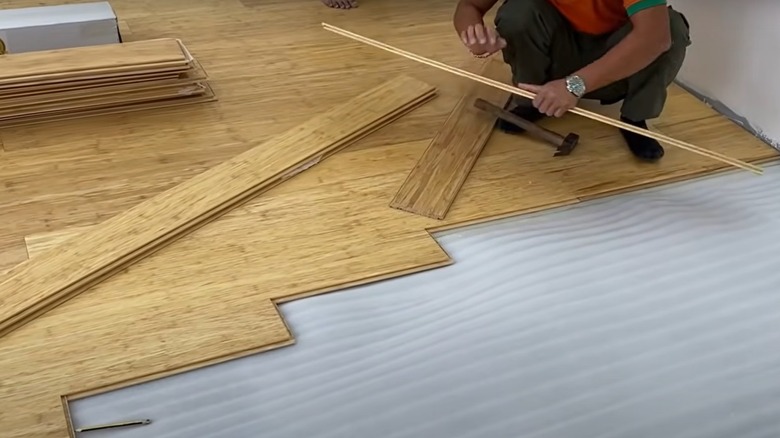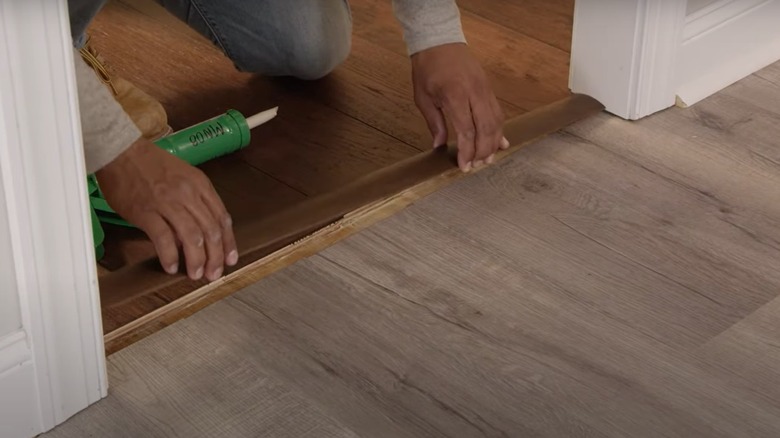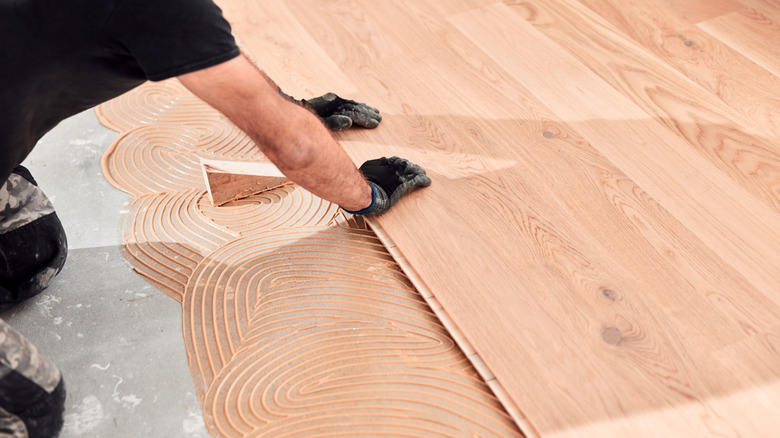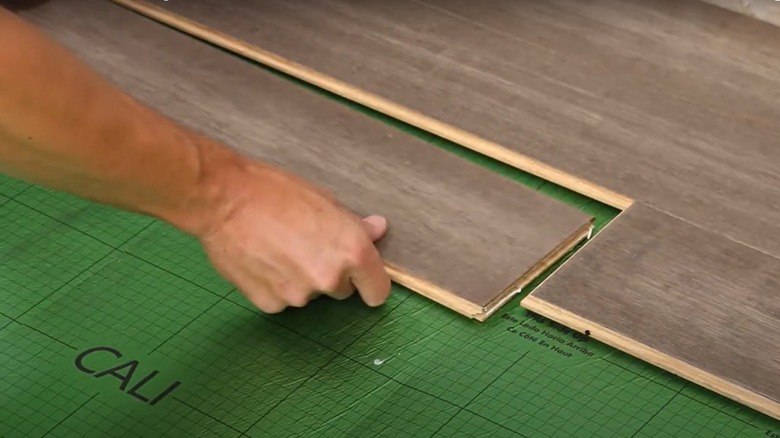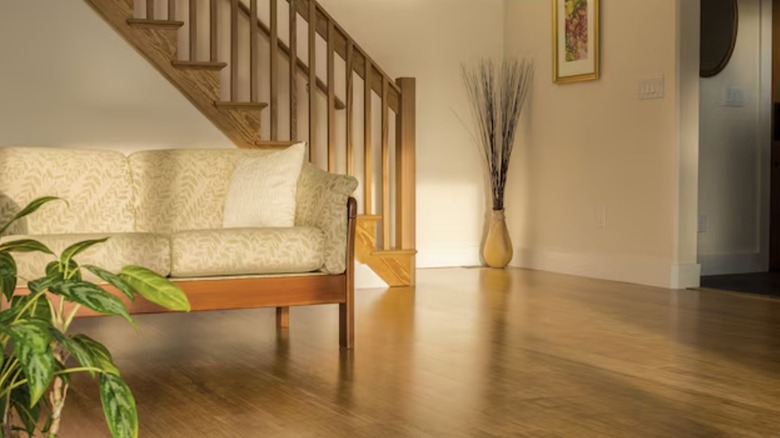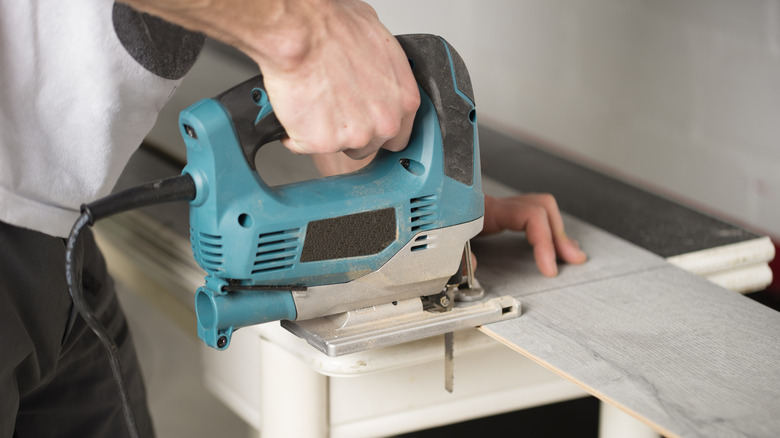Avoidable Bamboo Flooring Installation Mistakes You Don't Want To Make
We may receive a commission on purchases made from links.
Bamboo flooring is more than just attractive. It's known for its strength and durability, as well as being a sustainable resource that's cheaper than many other flooring options, such as hardwood. Another benefit of choosing bamboo flooring is that it is relatively easy to install. However, while installation may be easier than some other flooring materials, don't let that trick you into thinking it is foolproof.
There are still a number of mistakes you can make when installing bamboo floors in your home. These mistakes may have potentially significant consequences, such as warped or buckling planks, creating more work for yourself than necessary — or ending up with a floor that doesn't deliver the aesthetic appeal you were hoping for. Ahead, we'll explore some of the most common mistakes that can get in the way of properly installing bamboo flooring and share some tips for what you can do to avoid these common mishaps.
Failing to choose the best grain type for your home
Before you can begin thinking about installing new bamboo floors in your home, you'll need to purchase the planks for the project. As you start shopping, you will likely see different grain types available: horizontal, vertical, and strand-woven. The process used to create each of these grain options varies, and subsequently, the features, look, and performance of each type is also going to be different.
To make horizontal bamboo floors, small planks of bamboo are positioned in a horizontal orientation. These smaller planks are connected to one another and pressurized to secure them in place. This construction method leaves the growth rings of the bamboo stalks visible, which can add some intrigue to your flooring design. Vertical bamboo planks are made by attaching and pressurizing vertical strips of bamboo. Because the rings of the bamboo are facing sideways, they aren't visible when looking down at the floor. This leaves you with a more consistent surface that is relatively free of markings.
To make strand-woven bamboo planks, the bamboo plant is shredded. After being dried, the resulting fibers (strands) are glued together and pressurized into planks. This process yields planks that are superior to horizontal or vertical planks in terms of durability. As you may guess, because of its durability, strand-woven bamboo flooring will also be more expensive. While horizontal and vertical planks typically cost around $5 per square foot, you should expect to spend between $6 and $10 for strand-woven planks.
Not understanding the difference between solid and engineered strand-woven bamboo flooring
Now that we understand the difference between horizontal, vertical, and strand-woven bamboo planks, there is one other key thing to learn about. As you shop, you may notice that some planks are labeled solid strand-woven bamboo, while others are labeled engineered strand-woven bamboo. While both have "strand-woven" in their name, they are not the same, and there are some key considerations to keep in mind when deciding which type is best for your home.
Both of these options are made by compressing bamboo fibers and gluing them to one another. However, with solid strand-woven flooring, the entire plank consists of these compressed bamboo fibers. Engineered strand-woven planks, on the other hand, feature an upper layer made with these bamboo fibers, but the lower layer is plywood. If you might want to refinish your flooring in the future, engineered bamboo has one downside: It cannot be refinished. This is because the bamboo top layer is too thin to sand down. Conversely, as solid strand-woven bamboo flooring does not have that plywood base, it can be refinished, allowing you to keep your floors looking their best or even to change the stain on them.
There is one other notable difference between the flooring types — this one leaning in favor of engineered planks. Because of how it's constructed, it is possible to find planks that are longer or wider than what you'll find available with solid bamboo (think 7-inch wide planks). If your vision for your living space includes this look, then you might want to opt for engineered strand bamboo flooring over solid bamboo.
Not taking the plank type into consideration when planning for acclimation time
Just as it is important to acclimate hardwood floors before installing them, it is also essential to give your new bamboo flooring time to acclimate to your home before you install it. If you're not familiar with acclimating flooring, it is a process in which the new floors are given time to adjust to the temperature and humidity conditions in a home. Because of its porous nature, bamboo flooring can absorb or release moisture. As this happens, each plank may swell or shrink slightly. If the floors are installed without being able to acclimate to the space, these slight changes to the planks could spell big trouble, leaving the potential for gaps to form between the planks in the finished floor.
While acclimation is important for all types of hardwood and bamboo flooring, there are some unique considerations to keep in mind when you're working with bamboo. The specific moisture content of the flooring you're working with will dictate how long it should be given to acclimate to your home. Higher-quality bamboo flooring has a lower moisture content, so it won't take as long to acclimate — typically about 72 hours or so. However, lower-quality materials tend to have a higher moisture content, meaning they'll require a longer acclimation period (perhaps up to two weeks).
As you're planning your project, be sure to order your materials sufficiently ahead of when you want to install them to make sure the planks are given adequate time to adjust to the conditions in your home. Once you have the boxes of planks, cut a slit in the long side of each box to help the air reach inside. Stack them in a cross pattern, leaving space for air to flow around each box.
Failing to alternate planks from several boxes when laying the floor
Like most hardwood flooring, the precise shade of bamboo flooring planks can vary between boxes. This is because of the natural variations found in each bamboo stalk. For this reason, working out of one box at a time may be a mistake that you'll end up regretting. The color variations between boxes may be much more noticeable if you lay them one at a time, instead of mixing them up. Your floor may end up with patches of one color or pattern.
To avoid this mistake, it is important to open several boxes at a time — at least three or four — and alternate which box you grab a plank out before laying them on your floor. This will ensure that your floors have a natural look with more evenly spread out shading and patterns. You might want to lay out the planks for a large section of the room before you officially secure them in place. This will allow you to assess the overall look of the floor and make any desired adjustments.
One other important note: If you're working with carbonized bamboo, you should expect even more variances between the color and shading on different planks. These tone differences cannot be regulated, so keep this in mind when deciding if carbonized bamboo floors are the best choice for your home.
Assuming that strand bamboo trim pieces will be as easy to install
After installing your new bamboo floors, it will be time to move on to installing the trim. If you have experience installing wood trim, you may assume that you won't need to do anything differently when installing bamboo trim. Unfortunately, this line of thinking may end up getting you into trouble, as there is a key difference between wood and bamboo trim that impacts how easy each material is to secure.
Strand-woven bamboo is very durable — which is probably one of the reasons you're opting to install it in your home. This durability is because of the dense construction of each plank — and piece of trim — that is created when the individual bamboo strands are glued and pressurized. Because of how dense it is, you might not be successful if you simply try to use a nail gun to secure the trim into place. There are a few different options you can try instead. One is to pre-drill the holes in the trim before you try to secure them in place. With pre-drilled holes, you'll be able to shoot a nail through the pieces with greater ease. Another option is to use wood glue, like Titebond Premium Wood Glue, to attach these trim pieces.
If you want to simplify the task, or are planning multiple bamboo flooring installation projects, you could also consider investing in the right nail gun for the job. Models such as the DeWalt Pin Nailer, which can be used with micro-thin, 1-inch nails, should be able to penetrate the denser structure of bamboo trim.
Opting for a glue-down installation method when DIYing a bamboo floor
There are a few different options when it comes to installing bamboo floors. While each offers its own pros and cons, some are definitely more suited for DIYers than others, and choosing the wrong installation method is a mistake you don't want to make. A glue-down installation method is considered the most challenging. It would be better to hire a pro to install the flooring if you want to use this method, as it requires precise use of an adhesive to secure the planks to the subfloor. It is much easier to make a mistake — and if you do, you could even end up voiding the warrant from the manufacturer. A nail down method is one that homeowners could possibly consider, but still probably is one that is better suited for an experienced professional. Because of the hardness of the bamboo, correctly driving the nail or staple through the planks isn't as easy as one might guess. You'll also have to purchase or rent a staple gun or wood flooring nail gun, which can make this a less budget-friendly option.
If you are opting for a DIY installation, then you'll probably want to choose the floating method. This method doesn't need any glue or nails. Instead, a click-lock system is used to attach the planks to one another, and then it just "floats" over the subfloor. Because of how the planks are designed to fit snugly together, it also helps DIY installers ensure that their floor is free of gaps or noticeable seams. One note: You cannot use a click-lock installation method over joists; it will only work over a subfloor.
Not using the right underlayment can trigger moisture issues in bamboo flooring
Skipping underlayment is crucial mistake you don't want to make when installing wood flooring. Bamboo is no exception to this rule. Moreover, bamboo is very vulnerable to damage from moisture (even more so than hardwood), so not using the right underlayment — or skipping this step entirely — can be a huge mistake that results in disfigurement of the planks. There are a few things to know before buying flooring underlayment for bamboo. First, the best type of underlayment will depend on the installation method you're using.
As described above, a floating installation method, using click-lock planks, is an increasingly popular pick for DIYers. For this installation method, you'll want to opt for a 3-in-1 underlayment, such as AMERIQUE Premium Flooring Underlayment. This underlayment provides foam cushioning, insulations against sounds, and has a plastic vapor barrier to prevent moisture from damaging the flooring above it.
If you're opting for a nail-down installation method, you'll want to purchase roofing paper (15-pound felt paper). This type of underlayment will reduce the squeakiness that can occur when the bamboo planks rub against one another. It will also help wick dampness away from the floor, but will not deliver the same protection as the vapor barrier on a 3-in-1 underlayment. For this reason, it is essential to ensure your subfloor is properly sealed, particularly if it is over a damp basement, before laying the felt paper. A 3-in-1 underlayment will not work with a nail down method because the material could get punctured by a nail or staple, decreasing its effectiveness, as moisture will be able to penetrate the tiny holes. If you're using a glue-down method — or hiring a professional to install your floors with this method — no underlayment is necessary. However, you'll still want to make sure that the subfloor is properly prepared and sealed.
Not considering engineered bamboo if your home is prone to dampness and humidity
If your home is prone to dampness or higher humidity levels, you should take that into consideration when choosing bamboo flooring. In fact, solid bamboo may be a mistake for such homes. One downside of solid bamboo flooring is that it is not very water-resistant, so if it is installed in a home with moisture or humidity issues, it may become warped or otherwise damaged.
On the other hand, engineered strand bamboo — particularly click-lock versions — may be a safer pick. When constructing engineered planks, a layer of waterproofing is added to the base. If the humidity in your home fluctuates significantly between the summer and winter months, you can add a further layer of protection against warping and damage by limiting the run lengths less than 25 feet across the plank widths. However, this precaution can be discarded if your home's HVAC system features a humidity control feature.
It is important to note that, while more moisture-resistant than solid bamboo, engineered strand-woven bamboo is still not considered a waterproof material. For this reason, it is not recommended for use in a bathroom, laundry room, or other areas that are consistently humid or exposed to moisture.
Using a standard saw blade on strand-woven bamboo
If you already have all the tools for cutting vinyl flooring or hardwood on hand, you might assume that you can just use them to install your new bamboo floors, too. Unfortunately, this assumption could prove to be a mistake — especially if you try to use a standard saw blade to cut strand-woven bamboo planks. The planks are too dense for a standard saw to cut through them cleanly and neatly. Strand-woven bamboo planks are rated above 4,000 on the Janka Hardness scale. This makes them the densest type of wood flooring — more than twice as strong as maple and more than four times as hard as cherry.
To ensure you are able to achieve straight and smooth cuts, it is essential to have the right saw blade. An 80-tooth carbide blade — such as this WEN 80-Tooth Professional Woodworking Saw Blade — will help you easily and cleanly slice through each bamboo plank.
